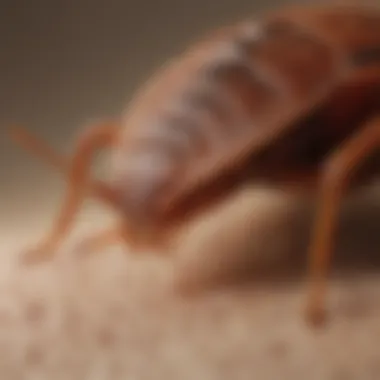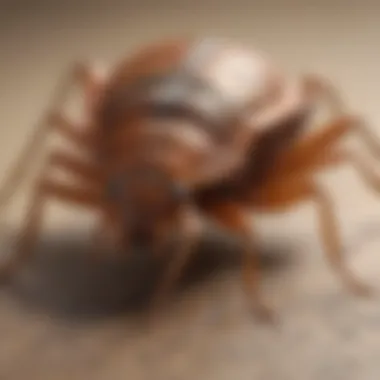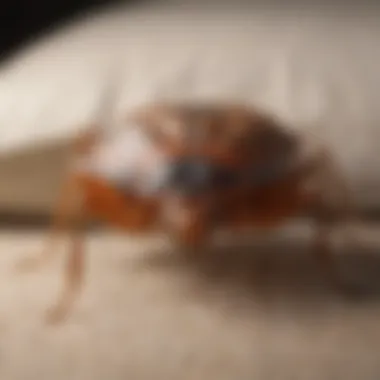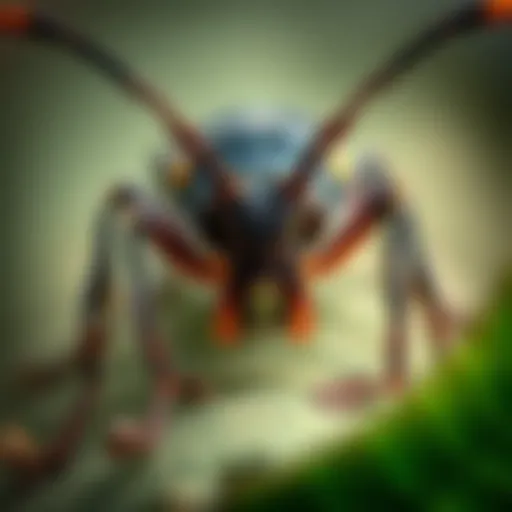Do Bed Bugs Make You Itch All Over?


Intro
Bed bugs have become a significant concern for many households around the world. These tiny, blood-feeding insects can lead to discomfort not just through their bites but also through the associated stress and anxiety around infestations. This article aims to inform readers about the science behind bed bug bites and the context of itching that many people experience following encounters with these pests. By understanding how bed bugs operate, identifying them, and effectively managing them, homeowners can mitigate the physical and mental effects of bed bug infestations.
Pest Identification
Identifying bed bugs in your home is crucial for effective management and prevention. Understanding common signs of these pests can help you take prompt action.
Common Household Pests
Bed bugs, officially known as Cimex lectularius, are often mistaken for other pests. Here are some characteristics of bed bugs:
- Size: Adult bed bugs are about the size of an apple seed, typically ranging from 4 to 5 mm in length.
- Color: They have a reddish-brown color, becoming brighter after feeding.
- Shape: Their bodies are flat and oval, making them easy to hide in crevices.
Signs of Infestation
Knowing how to spot signs of bed bug activity can help you address potential issues early.
- Bites: Itchy, red welts appear on the skin, usually in clusters or lines, indicating a possible bed bug bite.
- Blood Stains: Small blood spots on sheets and mattresses can be a sign of bed bug activity.
- Fecal Spots: Dark, tiny dots on bedding are evidence of bed bug droppings.
- Eggs and Shells: Empty shells and tiny white eggs found in hiding areas signal a growing problem.
"Understanding how to recognize bed bug signs is the first step toward effective action."
Prevention Methods
To avoid bed bug infestations, homeowners can implement practical prevention strategies.
Environmental Modifications
Making changes to your living environment can reduce the risk of bed bugs. Consider the following actions:
- Declutter: Reduce clutter in and around sleeping areas to minimize hiding spots.
- Use Mattress Covers: Encase your mattress in a bed bug-proof cover to protect it.
- Seal Cracks: Fill in any cracks or crevices in walls and furniture to limit access for pests.
Home Maintenance Tips
Routine maintenance can help keep your home bed bug-free. Regularly inspect and clean:
- Bedding and Fabrics: Wash and dry bedding on high heat to kill potential bugs and eggs.
- Furniture: Vacuum upholstered furniture thoroughly.
- Closets: Check clothing and storage for signs of infestation and ensure items are kept clean and organized.
DIY Pest Control Solutions
If you suspect a bed bug issue, some do-it-yourself (DIY) methods can help control the situation.
Natural Remedies
While some remedies may not completely eliminate bed bugs, they can act as deterrents:
- Diatomaceous Earth: This natural powder can be sprinkled in areas where bed bugs are suspected, helping to dehydrate them.
- Essential Oils: Mixtures of oils like tea tree and lavender may repel bed bugs, although effectiveness may vary.
DIY Traps and Barriers
Creating barriers or traps can also be useful:
- Sticky Traps: Place sticky traps near suspected entry points to catch bed bugs.
- Laundry Solutions: Use high-heat laundry methods for fabrics that may harbor bugs, as they cannot survive extreme temperatures.
The End
Understanding bed bugs and the itching they cause is crucial in managing infestations. Awareness of the signs and symptoms, combined with preventive measures and treatment options, empowers homeowners to take control of their living spaces. Keep a vigilant eye on your environment, and take action promptly to inhibit these pests from becoming a significant problem.
Prologue to Bed Bugs
Understanding bed bugs is crucial for anyone who wishes to maintain a comfortable and healthy living space. These persistent pests can lead to various problems, both physically and psychologically. This section offers insights about their nature, behavior, and the environments they occupy. Gaining knowledge about bed bugs can empower homeowners and housewives to identify issues early and take preventive actions.


Definition and Characteristics
Bed bugs, scientifically known as Cimex lectularius, are small, parasitic insects that feed exclusively on the blood of warm-blooded animals. Adult bed bugs are typically brown and measure about 4 to 5 millimeters in length. Their flat, oval bodies allow them to hide easily in small crevices. One of the key characteristics of bed bugs is their ability to breed quickly, with a single female capable of laying hundreds of eggs in her lifetime.
These insects are nocturnal, primarily feeding during the night when their hosts are unsuspecting. Unlike many other pests, bed bugs do not transmit diseases; however, their bites can cause significant discomfort and distress due to scratching and potential allergic reactions.
Common Habitats
Bed bugs prefer environments that provide ample opportunities for feeding. They are commonly found in places such as:
- Homes: Bedrooms are particularly vulnerable, especially around mattresses, bedding, and nightstands.
- Hotels: Frequent turnover of guests creates ideal conditions for bed bugs to spread.
- Public transportation: Areas like buses and trains can harbor bed bugs, allowing them to hitch a ride.
- Employment facilities: Offices and waiting areas can also be potential habitats, especially if people travel frequently.
Because bed bugs can easily travel with people, they spread rapidly across different environments. Understanding their habitats helps in developing effective management strategies.
Physiology of Bed Bug Bites
Understanding the physiology of bed bug bites is cruciale in comprehending the reactions that follow these bites. Bed bugs, small and elusive insects, have developed biological mechanisms to feed on human blood. This section delves into the intricacies of how bed bugs operate when they bite and introduces the role of their saliva in this process. Recognizing these factors can help in grasping not only the itch response but also broader aspects related to bed bug infestations. The knowledge gained here is beneficial for individuals dealing with pest management, providing them with valuable insights into minimizing discomfort as well as prevention.
Mechanism of Bite
When bed bugs attack, they utilize specialized mouthparts to penetrate the skin. These mouthparts are designed to pierce skin and access blood vessels efficiently. The process is deceptively simple but effective. Once the bed bug finds a suitable location, it inserts its mouthparts and begins to draw blood. Unlike many other insects, bed bugs do not just create a wound but inject substances to facilitate feeding. This action can happen without waking the host, a notable feature of bed bugs.
The saliva of bed bugs also plays a significant role during feeding. It contains anticoagulants that prevent blood clotting and aid in smooth feeding. This allows the bug to obtain a larger quantity of blood more easily. This mix of mechanics and biochemistry is essential not only for the bug's meal but also for the body's reaction. The bite often goes unnoticed at first, leading to a delayed response that can contribute to an individual's eventual discomfort.
Saliva Composition
The composition of bed bug saliva is intricate and plays a vital role in the feeding process. Bed bug saliva contains numerous proteins and enzymes, including anticoagulants and allergens. Anticoagulants, as mentioned, keep the blood from clotting, which is crucial for efficient feeding. Additionally, the saliva's unique composition can include saliva proteins that may trigger allergic reactions in sensitive individuals.
The allergens in bed bug saliva are responsible for the itchiness often felt after a bite. When the saliva enters the bloodstream, the immune system can recognize it as foreign, leading to the release of histamines. These histamines are what ultimately cause the sensation of itching.
In summary, the physiology behind bed bug bites is far more complex than it may initially appear. Understanding how bed bugs operate and the role their saliva plays in the feeding process provides vital knowledge for addressing the discomfort that follows bites. This awareness can also encourage a more proactive approach to managing infestations and reducing the likelihood of such encounters in the future.
The Itch Response: What Happens
Understanding the itch response is crucial when discussing bed bug bites. The discomfort that follows these bites is not just a mere annoyance; it is a complex physiological reaction that involves various bodily reactions. Believing that this response is entirely based on the bite itself is an oversimplification. The itch can vary in intensity among individuals, influenced by their body’s particular immune response and other factors.
When bed bugs bite, they inject saliva into the skin, which is one of the primary triggers for the itch sensation. This process leads to a cascade of biological events that contribute to the uncomfortable feeling people experience after being bitten. An exploration into this specific area sheds light on why some individuals may feel an overwhelming urge to scratch, while others might experience a more subdued reaction. It is important to acknowledge this variance, as it points to underlying immune mechanisms that can reflect an individual’s overall health.
Histamine Release
Histamine plays a central role in the body’s response to bed bug bites. When the bed bug's saliva enters the bloodstream, it prompts the immune system to react. This reaction is particularly notable with the release of histamine from mast cells, which are present throughout the body. Histamine causes blood vessels to expand, leading to redness and swelling in the affected area, amplifying the sensation of itch. The itching arises directly from the interaction of histamine with a specific group of receptors known as receptors.
The importance of understanding histamine release lies in its connection to allergic reactions. Given that this reaction can vary significantly among individuals, recognition of this aspect is particularly relevant for those with pre-existing allergies. Moreover, it opens up paths for potential treatment options targeting histamine pathways, providing relief to those suffering from intense itching.
Itch Receptors and Pathways
The sensation of itching is not uniform; it's a complex interaction involving various receptors in the skin. Once histamine binds to its receptors, itch-specific sensory neurons become activated. These neurons send signals to the spinal cord and, subsequently, to the brain. In this process, two key types of receptors come into play: TRPV1 and TRPA1. These receptors are crucial for how we perceive itch and pain, activating a response that can lead to intense scratching.
Understanding these pathways is essential. For instance, some treatments may focus on interrupting these neuronal signals, potentially limiting the urge to scratch. Additionally, it can inform individuals on ways to manage discomfort and seek relief when dealing with bed bug infestations. Such knowledge empowers people to make informed decisions about their responses to bites and promotes a better understanding of their biological reactions.
"The itch response to bed bug bites reflects not only the immediate physical discomfort but also broader implications for individual health and well-being."
In summary, the itch response involves a cascade of reactions initiated by histamine release, engaging various receptors that activate the central nervous system. This makes it crucial to understand both the physiological mechanisms and individual variations that determine the itch levels during a bed bug infestation.
Individual Differences in Itching
Understanding individual differences in itching caused by bed bug bites is essential. It highlights how reactions vary among people. These variations can affect the management strategies for dealing with infestations. Recognizing that not everyone experiences the same level of discomfort helps to tailor responses. This ultimately improves the lives of those affected.
Allergic Reactions
Allergic reactions play a significant role in how bed bug bites are perceived. When bitten, some individuals can develop an allergic response. This response may include severe itching, swelling, or even hives. Allergic reactions occur due to the person's immune system overreacting to the proteins in bed bug saliva. Some people may only experience mild irritation, while others face intense itching and discomfort.
Allergic responses vary significantly. Understanding this can guide treatment options.


For example, individuals with a history of allergies may be at higher risk for more severe reactions. Environmental factors can also influence responses. For instance, stress or existing skin conditions might exacerbate the itchiness. It underscores the need for customized approaches to treatment.
Sensitivity Variations
Sensitivity to bed bugs is another critical aspect. Each person has a unique threshold for pain and discomfort. Some may barely notice a bite, while others find it very bothersome. Sensitivity can be influenced by various factors like genetics, skin type, or prior exposure to bed bugs.
People with sensitive skin might react more intensely to bites. Skin conditions like eczema can complicate this, leading to increased itching. It is essential to recognize these differences for effective management.
Further, understanding one's sensitivity can help in preventive measures. If someone knows they react strongly to bites, they may take extra precautions against bed bugs. This could involve more rigorous cleaning practices or using protective measures during sleep.
Recognizing these variables not only assists in personal management but can also aid in broader public awareness efforts. Better education around individual experiences may lead to enhanced detection and treatment protocols.
Psychological Aspects of Bed Bug Infestations
The psychological impact of bed bug infestations often extends beyond the physical discomfort caused by their bites. Understanding these psychological effects is crucial as they influence the well-being and quality of life of those affected. Bed bugs can induce a cycle of anxiety and stress that may overwhelm individuals, leading to various emotional and mental health issues. Additionally, the presence of these pests can disrupt daily routines and alter emotional states.
Anxiety and Bed Bugs
Anxiety is one of the foremost psychological responses associated with bed bug infestations. The fear of being bitten can lead to increased vigilance and worry, disrupting normal behavior. This anxiety can manifest in several ways. For some, it causes obsessive checking of bedding and clothing for signs of bed bugs. Others might avoid certain places, fearing they may have bed bugs, thus limiting their social interactions.
Studies show that the psychological distress due to bed bugs can resemble post-traumatic stress disorder (PTSD) symptoms. Individuals may experience sleep disturbances due to heightened apprehension about the infestation. The constant fear creates a barrier to relaxation, resulting in diminished overall health. For those diagnosed with high anxiety levels, the situation can become increasingly hard to manage, necessitating mental health support.
"The psychological burden of bed bugs can often be more profound than the physical symptoms, highlighting the need for a comprehensive approach to pest control that includes mental well-being."
Impact on Sleep Quality
Sleep quality is significantly affected by bed bug infestations. The worry and fear of bed bug bites can lead to a constant state of alertness, making it difficult to fall or stay asleep. Poor sleep quality contributes to emotional instability and a decline in cognitive functions.
People may suffer from insomnia, leading to fatigue during the day, which in turn can affect their performance at work and the ability to engage in daily activities. Repeated sleepless nights can create a sense of dread associated with bedtime, as individuals anticipate a restless night filled with anxiety about potential bites.
In summary, both anxiety and sleep disruption serve as direct consequences of bed bug infestations. Addressing these psychological factors is essential in combating the overall impact of bed bugs on daily life. Considering the mental health aspects alongside the physical discomfort can result in a more thorough approach to managing bed bug issues.
Symptoms of Bed Bug Bites
Understanding the symptoms of bed bug bites is crucial for anyone suspected of having these pests in their living spaces. Unlike other insect bites, bed bug bites possess distinctive characteristics that assist in identification. Recognizing these symptoms can lead to timely treatment and management, reducing discomfort and potential infection. Furthermore, the psychological toll of realizing one has a bed bug problem can exacerbate the physical symptoms. Thus, both awareness and understanding serve as powerful tools against these unwelcome intruders.
Rash Patterns and Presentation
Bed bug bites often present as small, red welts or bumps on the skin. They can vary in shape and size, typically appearing in groups or clusters, often in a linear pattern. This arrangement occurs as a single bed bug can bite multiple times in one session. The bites usually take several days to manifest, distinguishing them from other insect bites that show immediate reactions.
In some cases, individuals may experience a rash resembling hives or severe allergic reaction. This is due to the body's response to the saliva injected during the bite. The presence of multiple bites can cause significant discomfort and lead to scratching, which risks secondary infections.
Identifying these specific rash patterns is critical. For example, bites may appear in exposed areas such as arms, legs, or neck, while areas covered by clothing may remain untouched. Knowing these signs can facilitate prompt action to address the issue, potentially leading to less severe symptoms.
Duration and Healing
The duration and healing of bed bug bites can vary widely among individuals. Most bites will fade within one to two weeks, but this timeframe can be prolonged for those who exhibit allergic reactions or have sensitive skin. During healing, the appearance of the bites may change, ranging from initial redness to eventual browning or pigmentation.
It is common for bites to itch intensely during the healing process. This itching may last longer in some individuals, causing frustration and considerable discomfort.
Bed bug bites and their symptoms can mimic other conditions, which complicates self-diagnosis. Consulting a healthcare professional for accurate assessment is often necessary.
Proper wound care is essential in managing the bites. Cleaning the area with soap and water helps prevent infection. Over-the-counter antihistamines can alleviate itching, while topical creams may provide additional relief. To support a quicker recovery, minimizing scratching is vital to avoid further irritation and scarring.
Management of Bed Bug Bites
Managing bed bug bites requires a systematic approach that addresses both immediate relief and long-term prevention. Understanding this topic is critical for those who may encounter these pests. Bed bug bites can lead to discomfort, secondary infections, or even psychological stress. Therefore, knowing how to effectively manage bed bug bites can alleviate physical symptoms and contribute to overall well-being.
Treatment Options
When it comes to treating bed bug bites, options range from home remedies to medical interventions. Below are some common treatment methods:


- Topical Creams: Over-the-counter hydrocortisone creams can help reduce itching and inflammation. Applying these should soothe the skin.
- Antihistamines: Oral antihistamines such as diphenhydramine can be effective in reducing itchiness. These medications work by blocking histamine, a key component that triggers allergic reactions.
- Cold Compresses: Applying a cold compress can offer immediate relief. This helps soothe itching and reduce swelling.
- Prescription Medications: For severe reactions, a doctor may recommend stronger prescription treatments, including corticosteroids.
In severe cases, it is essential to consult healthcare professionals for personalized treatment plans to prevent secondary infections.
Preventive Measures
Preventing bed bug bites involves a multi-faceted strategy. Here are several key preventive measures:
- Regular Inspections: Routinely check bedding, furniture, and other areas for signs of infestations such as dark spots (excrement) or shed skins.
- Encasements: Utilize bedbug-proof mattress and pillow encasements. These can help trap any existing bugs and make it hard for new ones to reach you.
- Cleanliness: Maintaining a clean living area also plays a crucial role. Wash linens regularly in hot water and vacuum the floors of your home often to avoid harboring pests.
- Travel Precautions: Always inspect hotel rooms before settling in. Look under beds and in crevices. Consider placing luggage on elevated surfaces.
- Professional Help: If there’s a suspected infestation, consulting with pest control experts is a wise choice. They can identify problem areas and recommend appropriate treatments.
"Awareness and proactive measures can significantly reduce the likelihood of facing bed bug issues."
Combining immediate treatment and preventive measures can effectively reduce the impact of bed bug bites on daily life. Addressing the issue at both levels ensures not only relief from discomfort but also a strategy for a pest-free living environment.
Long-Term Solutions for Bed Bug Issues
The presence of bed bugs can be distressing. Their bites often lead to numerous physical and psychological challenges. Effective long-term solutions are essential to eliminate these pests and mitigate their impact on individuals. Understanding these solutions can empower homeowners, especially housewives, to take control of their living environments.
Professional Pest Control
Engaging professional pest control services can provide a comprehensive solution to bed bug infestations. These experts possess the knowledge and experience needed to assess the extent of the infestation accurately. They can implement targeted treatments that go beyond standard do-it-yourself methods. The benefits of professional intervention include:
- Thorough Inspection: Trained professionals can identify hiding spots and routes bed bugs typically use, ensuring no part of the home is overlooked.
- Tailored Treatment Plans: Each infestation is unique. Pest control experts can develop customized strategies that address specific situations effectively.
- Use of Advanced Techniques: Professionals often utilize advanced methods such as heat treatments and insecticides that may not be available for consumer use.
- Continued Support and Advice: Many services offer follow-up visits to ensure the effectiveness of treatments and provide guidance on preventing future infestations.
While the cost can be a consideration, investing in professional pest control can save time, reduce stress, and ensure a more thorough eradication compared to other methods.
DIY Approaches
For those inclined to tackle bed bug issues independently, there are several effective DIY strategies. While these may not guarantee complete elimination, they can serve as a first line of defense. Consider the following strategies:
- Heat Treatment: Bed bugs are sensitive to heat. Washing bedding and affected fabrics in hot water, followed by drying on high heat, can kill bugs and eggs.
- Vacuuming: Regular vacuuming can help remove visible bed bugs and debris. It is essential to dispose of the vacuum bag immediately to prevent bugs from re-entering the home.
- Sealing Cracks and Crevices: Inspecting and sealing any potential entry points in walls, baseboards, or furniture can help reduce Bed Bug hiding spots.
- Bed Bug Interceptors: Setting up interceptors under bed legs can help monitor and trap any bugs that leave the mattress.
While DIY approaches can be a proactive step, they often require ongoing effort and should be combined with preventative measures to effectively manage and reduce the likelihood of future infestations.
Bed bug infestations need practical and sustainable solutions. The right combination of professional services and individual efforts can lead to a pest-free home, ensuring both comfort and peace of mind.
The Role of Awareness in Prevention
Awareness is a crucial component in the prevention of bed bug infestations and their associated discomforts. With the rise in travel and international trade, bed bugs have become more prevalent in various environments. Understanding the role of awareness not only empowers individuals to take proactive measures but also ensures they can respond effectively to potential infestations. This section will cover key elements that underline the importance of awareness, the benefits of identifying bed bugs early, and considerations for maintaining a bug-free home.
Awareness helps individuals recognize potential signs of infestation, allowing for swift action. Bed bugs are elusive creatures, often hiding in small crevices and seams of furniture. A lack of knowledge can lead to delays in addressing the problem, allowing these pests to reproduce rapidly. Homeowners must be informed about where bed bugs typically reside, their habits, and the common signs of infestations. By elevating awareness, individuals can foster a vigilant approach that promotes early detection.
Among the benefits of awareness is the ability to make informed decisions about pest control strategies. Understanding the biology and behavior of bed bugs aids in selecting appropriate responses—whether it be preventive measures or professional extermination. Additionally, consulting educational resources can equip individuals with the knowledge they require to minimize risks.
In summary, awareness plays an indispensable role in preventing bed bug issues. An informed individual is better equipped to maintain a safe and pleasant living environment.
Identifying Early Signs
Identifying early signs of bed bugs is essential in preventing larger infestations. Common indicators include:
- Bite marks on the skin, usually forming in a group of three or four.
- Small blood stains on bedding or mattresses, often a result of crushed bugs.
- Dark spots on sheets, which are fecal remnants from bed bugs.
- Shed skins and eggs in hiding places, indicating that bugs are present.
Becoming familiar with these signs helps in quickly determining the presence of bed bugs. Noticing these indicators promptly can facilitate rapid response, reducing the chances of a widespread infestation.
Educational Resources
Utilizing educational resources can enhance one's understanding of bed bugs and their prevention. Several platforms offer valuable information:
- Wikipedia: Provides a comprehensive overview of bed bugs, their lifecycle, and hatch rates.
- Britannica: Offers insights into the history of bed bugs and their adaptations.
- Reddit: A community-driven platform where individuals share personal experiences, tips, and advice about dealing with infestations.
Engaging with such resources prepares homeowners for the possibility of infestations and empowers them to take decisive action against bed bugs. Armed with the right information, individuals can safeguard their homes and minimize the impact of these pests.
End
Understanding the connection between bed bug bites and the experience of itching is crucial for effectively managing infestations. This article has explored various facets of bites and the responses they evoke in individuals. The physiological effects, including histamine release and individual sensitivity, illustrate just how complex the itching response can be.
Summary of Key Points
- Bed Bug Biology: Bed bugs are small insects that feed on human blood, primarily at night. Their bites can result in notable physical reactions, notably itching.
- Biting Mechanism: The mechanism of the bite involves saliva that triggers allergic reactions in some individuals leading to persistent itching.
- Impact on Life: Beyond physical symptoms, bed bug infestations can lead to psychological stress and anxiety that significantly disrupt daily routines and sleep.
- Prevention and Management: A thorough understanding of bed bug behavior aids in developing effective prevention strategies and treatment options, including professional pest control and DIY approaches.















